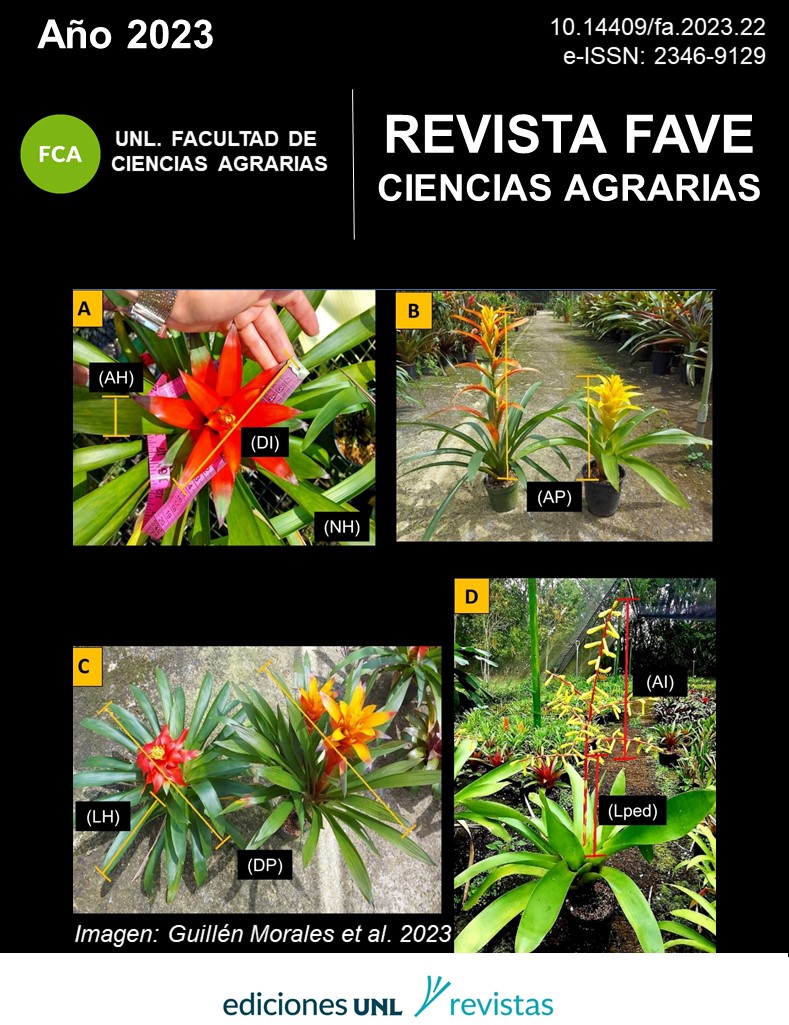Evaluation of the agronomic performance of cabbage (Brassica oleracea var. capitata) with the application of two organic fertilizers in the Pangua canton, Ecuador
DOI:
https://doi.org/10.14409/fa.2023.22.e0015Keywords:
tratamientos, adaptability, organic fertilizers, doses, treatmentsAbstract
Organic fertilizers are one of the alternatives within the group of products used in sustainable agriculture. The objective of this research was to evaluate the agronomic performance of cabbage (Brassica oleracea var. capitata) with the application of two organic fertilizers (poultry manure and compost in the Pangua Canton, the doses used were: 2 kg, 4 kg and 6 kg per square meter. The study was carried out at the San Luis Farm belonging to the Corazón Parish of Pangua Canton, the research had a duration of 90 days for the establishment of the trial and experimental work. The evaluation of the data was carried out at three ages: 30, 60 and 90 days, a completely randomized block design was used, with a factorial arrangement of A*B + a control (without fertilizer) with seven treatments, three replications and 20 plants as experimental unit. The variables evaluated were: plant height, stem diameter, cabbage diameter, cabbage weight and yield per hectare. The results showed that the application of the compost organic fertilizer yielded better results, while the other treatments reported inferior results. The results at field level showed the best effect where compost was applied. The agronomic behavior of the cabbage showed an adequate response to the application of organic fertilizer and adaptability to the climatic conditions of the area with the best results for the 6 kg dose.
References
Alburquerque, J. A., Bautista-Carrascosa, I., Lidón, A., García-de-la-Fuente, R., Girbent, J., Abad, M., & Cegarra, J. (2009). Co-composting an animal fatty-proteinaceous waste with a solid lignocellulosic by-product from the olive oil industry (‘alperujo’). Journal of Chemical Technology & Biotechnology, 84(6), 918-926. https://doi.org/10.1002/jctb.2152
Arango, M. J. (2017). Abonos orgánicos como alternativa para la conservación y mejoramiento de los suelos [Tesis de grado de Especialista en Gerencia Agropecuaria, Corporación Universitaria Lasallista]. http://repository.unilasallista.edu.co/dspace//handle/10567/2036
Casas, S., Guerra Casas, L. D., Casas Rodríguez, S., & Guerra Casas, L. D. (2020). La gallinaza, efecto en el medio ambiente y posibilidades de reutilización. Revista de Producción Animal, 32(3), 87-102.
Di Rienzo, J. A., Casanoves, F., Balzarini, M. G., Gonzalez, L., Tablada, M., & Robledo, C. W. (2008). InfoStat, versión 2008. Grupo InfoStat, FCA, Universidad Nacional de Córdoba, Argentina, 115.
Díaz-Franco, A., Alvarado-Carrillo, M., Alejandro-Allende, F., & Ortiz-Chairez, F. E. (2017). Organic manure and arbuscular mycorrhizal use on cabbage production. Revista Chapingo Serie Zonas Áridas, 16(1), 15-21.
INAMHI. (2019). Instituto Nacional de Meteorología e Hidrología el Corazón.
Martínez, A. F. (2021). Efecto de Metabolismos de Fitorregulación en el cultivo de col en el Cantón Milagro [Universidad Agraria del Ecuador, Trabajo Experimental de Ingeniero Agrónomo]. https://cia.uagraria.edu.ec/Archivos/ALVAREZ%20AZA%C3%91A%20CRISTHIAN%20ENRIQUE.pdf
Oliva, M., Neri, J., Guaman, E., Oyarse, S., & Silva, R. (2017). Efecto de la aplicación de abonos orgánicos sobre el rendimiento de repollo Corazón de Buey (Brassica oleracea) en Chachapoyas, Amazonas. Revista de Investigación de Agroproducción Sustentable, 1(3), 20-27.
Palacios, J. U. (2014). Comportamiento agronómico de las hortalizas col verde (Brassica oleracea var. Viridis), col morada (Brassica oleracea var. Capitata), con dos tipos de fertilizantes orgánicos en el centro experimental “La Playita [Tesis de Ingeniero Agónomo, Universidad Técnica de Cotopaxi. la Maná]. http://repositorio.utc.edu.ec/handle/27000/3527
Paño, E. A. (2018). Contribución de dolomita y humus de lombriz en la producción de repollo (Brassica oleracea L. variedad capitata) Centro Agronómico K’ayra – Cusco [Tesis de Ingeniero Agrónomo, Universidad Nacional de San Antonio Abad del Cusco]. http://repositorio.unsaac.edu.pe/bitstream/handle/20.500.12918/3522/253T20180124_TC.pdf?sequence=1
Peas, J. (2019). Evaluación de tres dosis de fertilizante foliar orgánico en el rendimiento y calidad del cultivo de col morada (Brassica oleracea) variedad “Capitata”, en el distrito de Lamas. Tesis de Ingeniero Agrónomo, Universidad de San Martin Tarapotó Perú. http://repositorio.unsm.edu.pe/handle/11458/3675
Pérez, J. J. R., Murillo, R. A. L., Bermeo, M. del R. R., Fernández, G. S., Méndez, C. I. U., Herrada, M. R., Bravo, D. A. C., Mendoza, A. F. A., & Rodríguez, J. C. G. (2016). Abonos orgánicos y su efecto en el crecimiento y desarrollo de la Col (Brassica oleracea L). Biotecnia, 18(3), 28-32.
Rea, F. D. (2012). Respuesta del cultivo de col (Brassica olerácea) a la aplicación de tres tipos de abonadura orgánica en la zona de Otavalo, provincia de Imbabura [Tesis de Ingeniero Agónomo, Universidad Técnica de Babahoyo]. http://dspace.utb.edu.ec/handle/49000/974
Published
How to Cite
Issue
Section
License
Copyright (c) 2023 FAVE Sección Ciencias Agrarias

This work is licensed under a Creative Commons Attribution-NonCommercial-ShareAlike 4.0 International License.

















